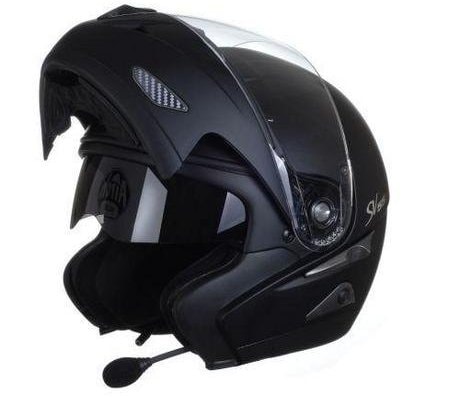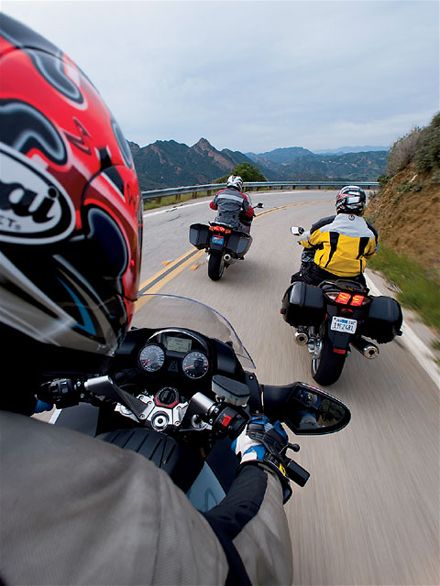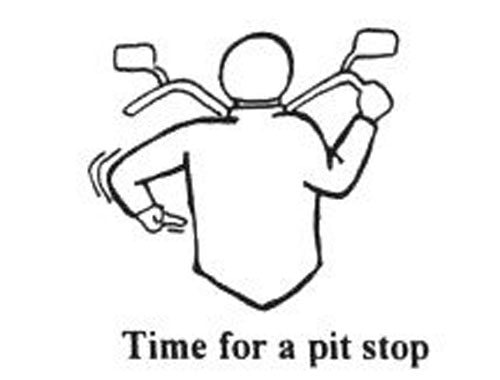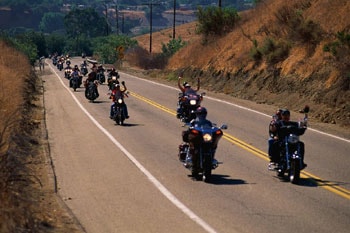Though many motorcyclists enjoy riding alone, there are moments (and not only a few) when it is needed to ride in group, whether it’s for going on a long distance trip or just for a boys/girls night out. Group riding is not as easy as you might think. There are some rules to be followed if you ride with others, each of them increasing your own and your group safety.
Advantages and Disadvantages
As said, most riders enjoy riding by themselves, since each of them have their own style and temper. However, a group is more visible to other traffic participants and also noisier than a single motorcyclist, not to mention the fact that you can have much more fun...in a group. Moreover, in case of technical difficulties, you have at least one pair of hands there to help you. Maybe there is even a mechanic in the group. In case of an accident, a fellow rider is more likely to know how to provide first aid, which is quite different if you are a motorcyclist. For example, the helmet should not be removed, unless it prevents you from breathing. If you have a mechanic that also knows first aid, place him as a tail gunner.
Of course, nobody says that group riding is flawless. Not anyone can ride in a group, as a certain experience and discipline is required. Not obeying the group rules increases the risks of accident, which in most cases involves several members of the group. So, if you have a personality problem, it’s better to meet with the others at the destination.
When you come to a stop at intersections, tighten the group to a side-by-side formation, and as the light turns green or as the traffic opens up, the bike on the left (which is usually the leader) proceeds first. Avoid blocking the intersection, as you are not alone out there. There are other traffic participants you should consider. When parking, try and get the group off the roadway as quickly as possible. When overcoming a slower vehicle, each group member should do it individually, in the order of arrival.
If you somehow got separated from the group, maintain your calm, as the group should have a pre-planned procedure for regrouping. Also, avoid side-by-side formation, as you will have less space if you need to swerve for avoiding a hazard. If you ride with a passenger, try and set up a group of rules to communicate with him/her as well. Don’t break the law and ... ride safe!
Of course, nobody says that group riding is flawless. Not anyone can ride in a group, as a certain experience and discipline is required. Not obeying the group rules increases the risks of accident, which in most cases involves several members of the group. So, if you have a personality problem, it’s better to meet with the others at the destination.
Organizing the ride
So you and your friends already decided to ride as a group to a certain destination. The best thing to do is all of you to gather up before the actual time of departure, to settle the main rules of the trip. First, pick your route. Since there are several riders, maybe one of you knows the best way to get there. Then, establish the stops you will make along the route. And last, the moment when pride interferes the most: creating the formation.The Formation
Every rider from the group should be aware of his own abilities, as well as of the limits of the motorcycles in the group. It’s for the better to organize the group formation based on key aspects, as follows:- The Road Captain - usually, he/she is the one who establishes the road formation and the group rules, but not without hearing what every group member has to say first. He/she also informs the missing members about the decisions made at the gathering. He/she should also check the route one week before the trip to identify the potential threats.
- The Leader - is the one of the most experienced bikers in the group and also the who rides first. He/she is the one who sets the group’s speed, direction, and lane changes. He/she also has to choose the tail gunner. It’s for the best that both of them carry a radio equipment.
- The Tail Gunner - is the one who closes the group, also one of the most experienced riders. He/she is the one that informs the leader about the eventual problems noticed with the rest of the members. When changing lanes, he/she should be the first to do it, in order to secure the group from cars coming from behind. He/she should ride with a passenger to help communicate with the leader through the radio equipment. The less experienced member should ride on the right side of the road, right in front of the tail gunner, which will by this protect him better.
Basic Maneuvers
It’s for the best to ride in a staggered riding formation, or when imposed, on a single-file formation. The leader should ride in the left third of the lane, while the next rider stays at least one second behind in the right third of the lane. The rest of the group should follow the same pattern. At departure, the leader and the tail gunner have to be sure that everybody is set to go.When you come to a stop at intersections, tighten the group to a side-by-side formation, and as the light turns green or as the traffic opens up, the bike on the left (which is usually the leader) proceeds first. Avoid blocking the intersection, as you are not alone out there. There are other traffic participants you should consider. When parking, try and get the group off the roadway as quickly as possible. When overcoming a slower vehicle, each group member should do it individually, in the order of arrival.
Communication
We already said the leader and the tail gunner should be equipped with radio devices. As you know, riders can’t just speak with each other while riding, it is recommended to have a set of hand signals to secure your good group ride. These signals should be informing about when it’s time to stop, slow down, speed up, turn signal on, comfort or refreshment stop, position changes, hazard in roadway and anything else you feel that might happen (for example if you ran out of fuel, or change to a single or double-file formation).What NOT to do?
Never join a group while it is moving and also never hit the bike in front of you. If you feel that you are misplaced in the group, try and talk about it with the leader at the first pit stop. Don’t think that you are a weaker rider if you feel it’s time to have a break before the pit-stop. Inform your tail gunner about this by using the hand signals you established.If you somehow got separated from the group, maintain your calm, as the group should have a pre-planned procedure for regrouping. Also, avoid side-by-side formation, as you will have less space if you need to swerve for avoiding a hazard. If you ride with a passenger, try and set up a group of rules to communicate with him/her as well. Don’t break the law and ... ride safe!



